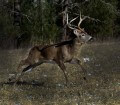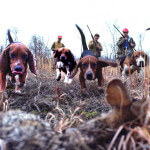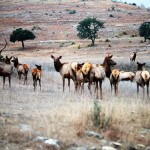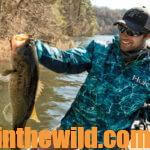John’s Note: One of the most-critical ingredients in recovering an arrowed deer is to know exactly what’s happened prior to, during and after the shot is taken.
The natural impulse of many hunters who have shot at deer upon returning to camp after dark is to organize a search party of as many people as possible to go with lights to the woods and try and recover the downed animal. But such was not the case with Kevin (See Days 1 – 3). He had hunted wounded deer before and recovered a large percentage of them. Instead of rounding up the troops and heading back into the moonless forest, Kevin stored his gear and sat down to supper. He reported the events of the hunt to his friends and asked Jim, one of the oldest hunters in the club, to go with him after supper to search for his deer. Two hours after Kevin had released his arrow at the 6-point buck, he and Jim were once again at his tree stand with a Coleman lantern preparing to trail the whitetail.
 Kevin now had the five-most-important ingredients required for night stalking on his side.
Kevin now had the five-most-important ingredients required for night stalking on his side.
(1) Time – Kevin had allowed enough time to elapse for the deer to lie down and die, if in fact the animal was mortally wounded.
(2) A Coleman lantern – This lantern puts out an extremely-bright, white light that causes blood to almost glow when the light hits it. This white light is also much better for trailing than the fading afternoon light found when many hunters attempt to track wounded deer.
 (3) An older hunter – If you can find a sportsman who has hunted the same land for many years where you hunt, your chances of recovering your quarry are greatly increased. Seasoned hunters often make mental notes as to where wounded deer will head on the land they hunt. I’ve known men who can sit next to the fire on a cold winter’s night and tell a hunter exactly where a wounded deed can be found without ever leaving the warmth of the hearth. Because of terrain, water and cover, severely wounded deer often will head for the same places that other deer on the property have used for havens previously. A hunter who has trailed many deer on the same property may understand instinctively where to look for a downed deer, once he discovers the direction of flight the animal has taken after the shot. Too, the veteran woodsman may prevent the archer from becoming lost before the deer is found, while he’s trailing, or even after the animal’s located. A hunter on the trail of a wounded deer may be so intent on recovering his trophy that he loses his bearings.
(3) An older hunter – If you can find a sportsman who has hunted the same land for many years where you hunt, your chances of recovering your quarry are greatly increased. Seasoned hunters often make mental notes as to where wounded deer will head on the land they hunt. I’ve known men who can sit next to the fire on a cold winter’s night and tell a hunter exactly where a wounded deed can be found without ever leaving the warmth of the hearth. Because of terrain, water and cover, severely wounded deer often will head for the same places that other deer on the property have used for havens previously. A hunter who has trailed many deer on the same property may understand instinctively where to look for a downed deer, once he discovers the direction of flight the animal has taken after the shot. Too, the veteran woodsman may prevent the archer from becoming lost before the deer is found, while he’s trailing, or even after the animal’s located. A hunter on the trail of a wounded deer may be so intent on recovering his trophy that he loses his bearings.
(4) A compass and a hand-held GPS – Although the man who has hunted an area for many years almost always will know the way home, just to be safe, both men should have this equipment and take a compass reading before beginning the search.
(5) Flagging tape – Bright orange flagging tape is a critical tool used in recovering game. The highly-visible orange ribbon can be placed along the trail to mark where important signs are found. The tape should be hung at eye level, so the hunter can see it easily. The flagging tape also provides a way out of even the most unfamiliar woods. After the deer is recovered, and hunters start out of the woods, the tape should be removed, so as not to litter the region.
 To get John E. Phillips’ Kindle eBooks and print books on hunting deer, “How to Hunt and Take Big Buck Deer on Small Properties,” “How to Hunt Deer Up Close: With Bows, Rifles, Muzzleloaders and Crossbows,” “PhD Whitetails: How to Hunt and Take the Smartest Deer on Any Property,” “How to Take Monster Bucks,” “How to Hunt Deer Like a Pro,” and “Bowhunting Deer: Mossy Oak Pros Know Bucks and Bows,” or to prepare venison, “Deer & Fixings,” click here.
To get John E. Phillips’ Kindle eBooks and print books on hunting deer, “How to Hunt and Take Big Buck Deer on Small Properties,” “How to Hunt Deer Up Close: With Bows, Rifles, Muzzleloaders and Crossbows,” “PhD Whitetails: How to Hunt and Take the Smartest Deer on Any Property,” “How to Take Monster Bucks,” “How to Hunt Deer Like a Pro,” and “Bowhunting Deer: Mossy Oak Pros Know Bucks and Bows,” or to prepare venison, “Deer & Fixings,” click here.
For information on making jerky from your deer to provide a protein-rich snack, you can download a free book from https://johninthewild.com/free-books.










